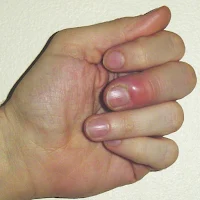Acute Paronychia
Introduction
Paronychia is an inflammation involving the lateral and proximal nail folds. It may be
- Acute - characterized by the rapid onset of painful erythema and swelling of proximal and lateral nail folds, usually in 2-5 days following a minor local trauma. A superficial abscess is present; lasting for <6 weeks.
- Chronic - gradual process and commonly occurs in individuals persistently exposed to environmental irritants and allergens (e.g. wet work, food, chemicals). Cultures of chronic paronychia are frequently positive for Candida spp., but it is unclear if yeast is a causative agent or colonizer of underlying inflammation; lasting for 6 weeks or longer.
Predisposing Factors
Predisposing factors include
- Overzealous manicuring
- Nail biting
- Picking at a hangnail
- Thumb sucking
- Ingrown nail
- Diabetes mellitus
- Occupations in which the hands are frequently immersed in water
- Drugs such as antiretroviral agents, systemic retinoids, epidermal growth factor receptor inhibitors (e.g. cetuximab, erlotinib, lapatinib) and taxanes.
Management of Acute Paronychia
Acute paronychia is most commonly caused by the inoculation of pathogens present in the skin flora (e.g. Staphylococcus aureus, Streptococcus pyogenes) into the periungual tissues by minor mechanical or chemical traumas that disrupt the nail fold barrier.
The treatment of acute paronychia without abscess includes
- Warm soaks for 10 to 15 minutes, 3-4 times a day.
- Topical antibiotics (e.g. mupirocin, fusidic acid plus betamethasone, gentamicin)
Referral to Doctor
- Empiric oral antibiotic therapy may be needed in more severe cases of acute paronychia that do not respond to topical treatment alone.
- Acute paronychia with abscess formation is generally treated with incision and drainage.
- For paronychia associated with ingrown toenails, address the ingrown toenail if possible.
- Refractory chronic paronychia - consider surgical intervention.

Comments
Post a Comment